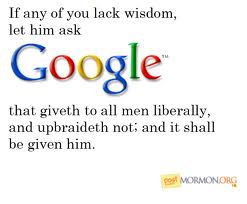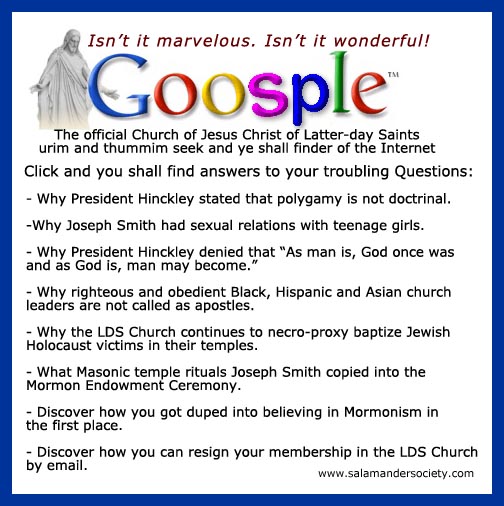Stormy Waters wrote:Since members are instructed not to read information that is critical to the church. I was wondering, how did most of the people who leave the church come into contact with information critical of the church? Did they read 'anti' material anyway?
My journey began strangely enough by reading the LDS Church News.
I came across this article about FAIR. I was excited to read about an organization that engaged in a responses to critics of the church. So I went to my computer and I entered the url provided in the article
http://www.fairlds.org. From there I navigated to the
Topical Guide page. I spent some time reading on the various topics. Then I spent years with my head in the sand. I just didn't want to know anymore than I already did.
This is part of why I think any attempts at inoculation will fail. Even though I'd come across this information on a 'friendly' site, the answers just aren't satisfying.
So I'd be interested to know, how did you come across information critical of the church?
While on my mission, there was an apostate living in one area to which I was assigned. He'd been a missionary there himself, more than 10 years earlier. After his mission, he returned and married one of the member daughters. When his apostasy occurred in relation to those events, I do not know. He coyly tried not to damage the testimonies of my companion and I, meeting with him in our lame attempt to reactivate him. His wife was active. To find out what his concerns were, so we (in our hubris thinking) could allay him of those concerns, clearing the way for his return to Church activity, he began exposing historical facts not in the correlated LDS narrative. He told us, doubters of what he was claiming, not to take his word for it, but that when we were done and each returned to BYU, to look it all up. Before leaving the area, I asked him to provide me a complete listing of what sources he was referring to. I was hell bent on returning to Provo, looking these sources up, and then explaining in a letter to him why he was wrong.
I did return. I checked out his list, mostly in books at the HBL Library on the BYU campus. Some of those referred to references that led to Special Collections, both there and at the U of U's library. So on Saturdays, I headed up to SLC. The more I dug in efforts to show that ex-missionary apostate where he was wrong, the more troubling information I found. Much more. I began engaging roommates and fellow students at BYU, even a couple of religion and Utah history professors I took classes from, in one on one discussions. Not to reveal my own doubts and questions, I took the posture that I wanted to share with them that I had found faith-promoting materials. I put my best faith-promoting spins on explaining what in fact were faith-killing historical facts. Most of the other students placated me, and when I would finish my blowhard explanation, would usually ask, do you want to order a pizza? A few of the professors gave responses that were the equivalent of a pat on a good dog's head and praise, without any substantive comment. There was strangely an aloofness in the response of one of them, which I had not expected with him as he had been one of the more gung-ho, TBM types in class.
One roommate who did not attend church on Sundays took my bait. He had not heard much of the facts that I had discovered and used to pepper my arguments. He'd keep saying that what I'd just said damned the LDS truth claims more than supported them as I was trying to argue--much the way that the lost 116-pages are treated by South Park.
After a couple of months, I retreated to re-examine my notes, to 'take a closer look' as the Mopologists are fond of saying. It became painfully evident that the LDS truth claims depended for their acceptance on the stark omission of large portions of the Kirtland, Missouri, and Nauvoo historical record (and I only had found pieces--but they exposed big gaps in the LDS narrative).
Then Quinn's book in the early '90s pretty much tied it altogether for me, even though that was not his purpose in writing it.
As for your comment about innoculation, if the LDS Church does it, it will purge the member ranks of those that would be troubled when they look anyway. It will leave in sacrament meetings a more Chapel Mormon pure congregation. Indeed, many will leave, tithing will be lost, but the LDS Church will then have a stronger hold on those that remain, being able to claim that its been honest and open. "Nothing to hide" will be their mantra. At least in this way, the effect of the historical truth will not be as insidious and an unseen corrosive on the membership as it is in Europe. How many other TBMs can an apostate take with him or her on the way out, chiding them that the LDS Church does not tell them these things, and BKP admonishes to leave it alone.

